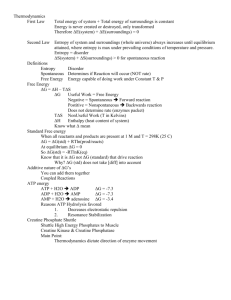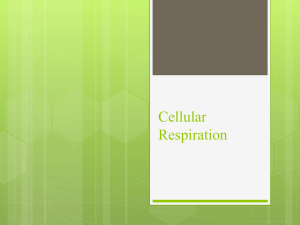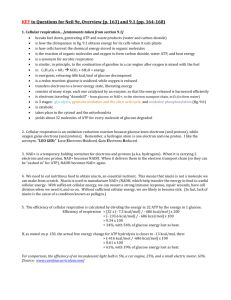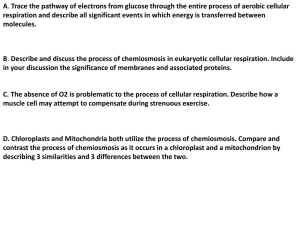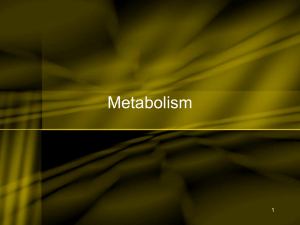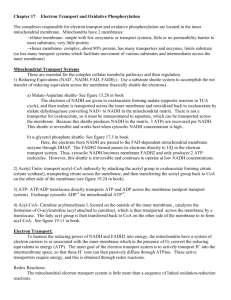Chapter 8 Notes – Energy and Metabolism
advertisement
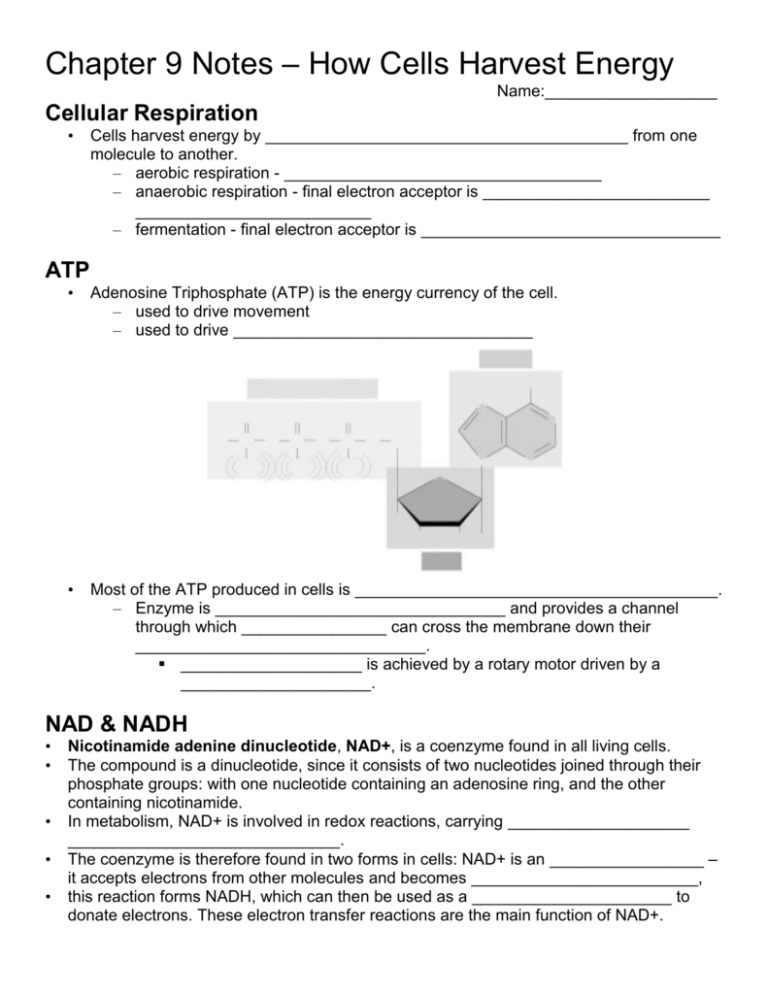
Chapter 9 Notes – How Cells Harvest Energy Name:___________________ Cellular Respiration • Cells harvest energy by ________________________________________ from one molecule to another. – aerobic respiration - ___________________________________ – anaerobic respiration - final electron acceptor is _________________________ __________________________ – fermentation - final electron acceptor is _________________________________ ATP • Adenosine Triphosphate (ATP) is the energy currency of the cell. – used to drive movement – used to drive _________________________________ • Most of the ATP produced in cells is ________________________________________. – Enzyme is ________________________________ and provides a channel through which ________________ can cross the membrane down their ________________________________. ____________________ is achieved by a rotary motor driven by a _____________________. NAD & NADH • • • • • Nicotinamide adenine dinucleotide, NAD+, is a coenzyme found in all living cells. The compound is a dinucleotide, since it consists of two nucleotides joined through their phosphate groups: with one nucleotide containing an adenosine ring, and the other containing nicotinamide. In metabolism, NAD+ is involved in redox reactions, carrying ____________________ ______________________________. The coenzyme is therefore found in two forms in cells: NAD+ is an _________________ – it accepts electrons from other molecules and becomes _________________________, this reaction forms NADH, which can then be used as a ______________________ to donate electrons. These electron transfer reactions are the main function of NAD+. The Cellular isms • Metabolism: is the set of ________________________________________________ ______________________________. – These processes allow organisms to _________________________________ _______________________________________. – Usually divided into two categories. • Catabolism and Anabolism – Catabolism – ______________________ – Anabolism – ______________________ What are anabolic steroids used for? Who would want to use catabolic drugs? • Catabolism: the set of metabolic pathways which ____________________________ ___________________________-. – Large molecules such as ________________________________ are broken down into smaller units such as __________________________________ ____________________________, respectively. – These processes _______________________________ • Anabolism: the set of metabolic pathways that _______________________________. – These reactions require ________________________. – Anabolism is powered by _______________________. Many anabolic processes are powered by _________________________________. – Anabolic processes tend toward ______________________ organs and tissues. – These processes produce ___________________________ of cells and increase in ______________, a process that involves __________________ of complex molecules. Glucose Catabolism • Cells __________________________ and produce ATP in two ways: – _________________________________________ – aerobic respiration in most organisms, both are combined _________________ _________________ _________________ _________________ Aerobic Respiration Stage One – Glycolysis • • • For each molecule of _________________e that passes through _____________, the cell nets ______________ molecules. Priming – glucose priming – cleavage and rearrangement Substrate-level phosphorylation – oxidation – ATP generation Priming Reactions Priming Reactions Glycolysis begins with the addition of _______________. Two ___________________ phosphates from two molecules of ________________ are added to the ______________ _________________ producing a sixcarbon molecule with two ______________________. Cleavage Reactions Cleavage Reactions Then, the six-carbon molecule with two phosphates is __________________________, forming two __________________________________________. Energy-Harvesting Reactions Energy Harvesting Reactions Finally, in a series of reactions, each of the two three-carbon sugar phosphates is converted to ____________ _____________________. In the process, an energy-rich _______________ is harvested as ___________________ and two ____________________ are formed. Recycling NADH • As long as ____________________ are available to be converted into glucose, a cell can produce ATP. – Continual production _______ __________ accumulation and ____________________. NADH must be recycled into NAD+. aerobic respiration fermentation Stage Two – Oxidation of Pyruvate Within __________________, pyruvate is ___________________, yielding acetyl-CoA, NADH, and CO2. Stage Three – Kreb’s Cycle • Acetyl-CoA is oxidized in a series of nine reactions. – two steps: priming energy extraction Overview of Kreb’s Cycle 1: _________________ 2-3: ________________ 4: _________________ 5: _________________ 6:__________________ 7: _________________ 8-9: ________________ Kreb’s Cycle Harvesting Energy by Extracting Electrons • Glucose catabolism involves a series of __________________________that release energy by ________________________________________ to oxygen atoms. – Energy is harvested from glucose molecules in ____________________, using NAD+ as an electron carrier Electron Transport Stage Four – Electron Transport Chain NADH molecules carry _________________ to the _______________________, where they transfer ________________ to a series of membrane-associated proteins. Electron Transport Chain Chemiosmosis ATP Generation This process begins with ____________ the product of ________________, and ends with the _________________. Theoretical Yield of Aerobic Respiration Regulating Aerobic Respiration • Control of glucose catabolism occurs at two key points in the catabolic pathway. – glycolysis - ___________________________ – Krebs cycle - _________________________ Electron Transport System (Video) Video In the mitochondrion, the energy stored in NADH is used to generate a proton gradient across the mitochondrial membrane and the energy of the proton gradient is used to make ATP. When glucose is oxidized during glycolysis and the Krebs Cycle, the co-enzymes NAD and FAD are reduced to NADH and FADH2. Inside the mitochondrial matrix, the electrons from NADH are transferred to the electron carrier Coenzyme Q by NADH dehydrogenase, and the protons are transferred across the membrane to the intermembrane space. Coenzyme Q carries the electrons to the cytochrome bci complex. As the electrons move from the bci to cytochrome c, more protons are carried from the inside to the outside of the membrane. Electrons are also transferred from FADH2 to Coenzyme Q, with the protons being transferred across the membrane. Cytochrome c transfers electrons to the cytochrome c oxidase complex. Protons are also transferred to the outside of the membrane by the cytochrome c oxidase complex. The cytochrome oxidase complex then transfers electrons from cytochrome c to oxygen, the terminal electron acceptor and water is formed as the product. The transfer of protons to the intermembrane space generates a proton motive force across the inner membrane of the mitochondrion. Since membranes are impermeable to ions, the protons that reenter the matrix pass through special proton channel proteins called ATP synthase. The energy derived from the movement of these protons is used to synthesize ATP from ADP and phosphate. Formation of ATP by this mechanism is referred to as oxidative phosphorylation. Control of Glucose Catabolism Catabolism of Proteins and Fats • • Proteins are utilized by ___________________________ their amino acids, and then metabolizing the product. Fats are utilized by beta-oxidation. Cellular Extraction of Chemical Energy Fermentation • Electrons that result from the glycolytic breakdown of glucose are donated to an organic molecule. – regenerates NAD+ from NADH ethanol fermentation lactic acid fermentation
